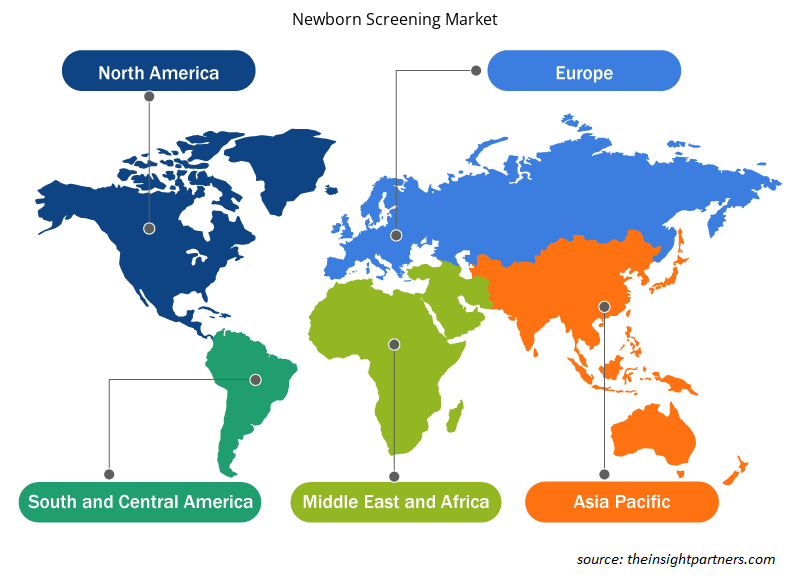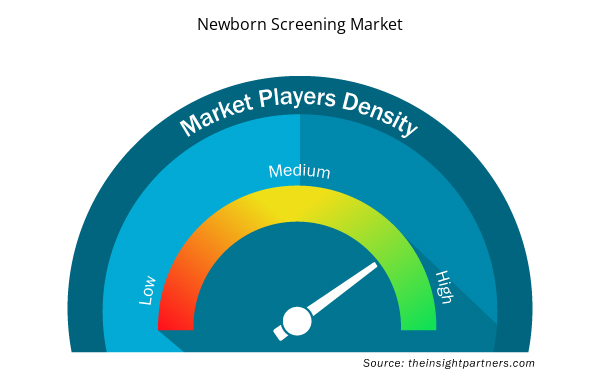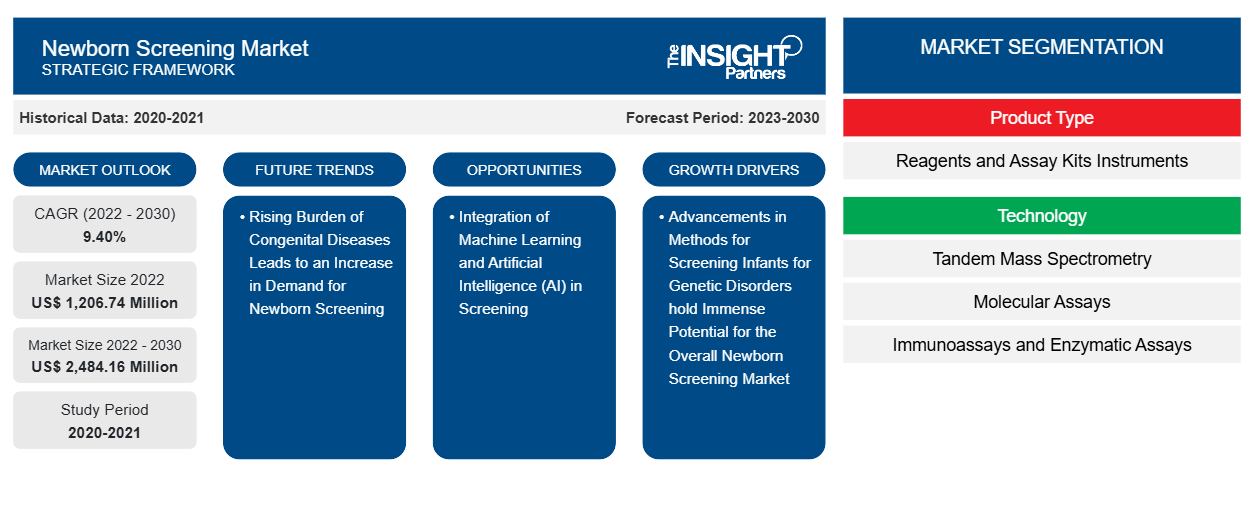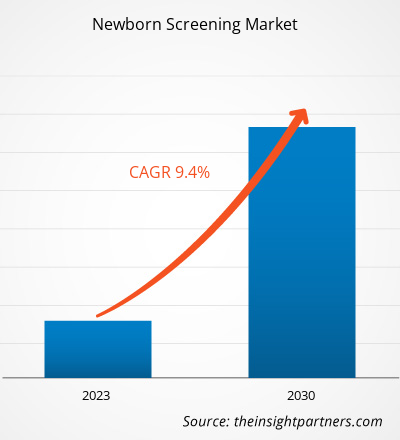新生儿筛查市场规模预计将从 2022 年的 12.0674 亿美元增至 2030 年的 24.8416 亿美元。预计 2022-2030 年期间市场复合年增长率将达到 9.40%。机器学习和人工智能 (AI) 在筛查中的整合可能仍将是市场的主要趋势。
新生儿筛查市场分析
由于政府和非营利组织开展的教育活动提高了公众和医疗保健提供者对新生儿疾病早期诊断和干预价值的认识,预计市场将增长。此外,出生率的提高也增加了新生儿筛查的需求,尤其是在发展中国家。新生儿筛查市场的利益相关者可以利用这些驱动因素和机会,改善早期检测和干预,并最终改善全球新生儿的健康状况。
新生儿筛查市场概况
各国政府越来越多地为新生儿筛查项目拨款。这些项目有助于降低儿童及其父母的长期医疗费用,因为先天性和遗传性疾病如果未被发现,可能会导致严重的健康并发症和广泛的医疗干预。通过识别和解决婴儿期的健康问题,政府可以改善其公民的健康和福祉。因此,新生儿筛查符合更广泛的公共卫生目标,即改善整体人口健康状况并减轻医疗保健系统的负担。
政府资金促进了医疗保健服务的公平性,确保新生儿筛查服务面向所有人,无论其社会经济地位如何。这种包容性对于早期疾病检测和干预至关重要,因为它可以防止不同人口群体之间的医疗保健结果出现差异。随着各国政府继续通过增加资金和政策支持将新生儿筛查列为优先事项,婴儿筛查市场在全球范围内一直经历着可持续增长。
定制此报告以满足您的需求
您可以免费定制任何报告,包括本报告的部分内容、国家级分析、Excel 数据包,以及为初创企业和大学提供优惠和折扣
- 获取此报告的关键市场趋势。这个免费样品将包括数据分析,从市场趋势到估计和预测。
新生儿筛查市场驱动因素和机遇
先天性疾病负担加重导致新生儿筛查需求增加,有利于市场增长
先天性疾病若不及早发现和治疗,将导致终身健康问题。这些疾病可能导致长期残疾,严重影响家庭、个人、医疗保健系统和社会。世界卫生组织估计,全球每年有 240,000 名新生儿在出生后 28 天内死于这些疾病。另有 170,000 名 1 个月至 5 岁之间的儿童死于先天性疾病。对许多先天性疾病遗传基础的了解日益加深是导致这些疾病负担加重的几个因素之一。基因组学和基因检测的进步使医疗保健提供者能够识别新生儿更广泛的基因突变和疾病。这些扩展的知识凸显了通过新生儿筛查进行早期诊断以及时进行干预和治疗的重要性。
人口统计学因素的变化(例如母亲年龄、环境暴露和生活习惯的改变)会增加新生儿患先天性疾病的风险。此外,由于全球人口的迅速增长,每天出生的婴儿数量也在增加,导致越来越多的婴儿面临先天性疾病的风险。此外,医疗保健系统和政策制定者认识到早期疾病检测的长期益处。他们越来越多地将新生儿筛查纳入常规医疗保健方案和保险范围,进一步刺激市场增长。先天性疾病负担的增加是新生儿筛查市场发展的重要驱动力。
婴儿遗传疾病筛查方法的进步为整个新生儿筛查市场带来巨大潜力
随着人们对疾病遗传原因的了解不断加深,以及医疗技术的进步,对新生儿进行全面基因筛查的需求也在不断增长。因此,新生儿筛查市场的公司正在开发创新、经济高效的筛查解决方案。美国 FDA 于 2017 年批准 Kymriah 基因疗法用于治疗患有特定类型急性淋巴细胞白血病的儿科患者。在这种治疗过程中,一种编码嵌合抗原受体的新基因被插入患者的 T 细胞中,刺激改变后的 T 细胞追踪并摧毁白血病细胞。Yescarta 和 Zynteglo 是另外两个获得批准的用于治疗大 B 细胞淋巴瘤和β-地中海贫血的基因疗法。此外,能够识别出生时疾病遗传倾向的技术的出现为个性化医疗铺平了道路,与精准医疗的大趋势相一致。
妊娠期间遗传病筛查也侧重于妊娠相关问题的早期发现。下一代测序有助于新生儿产前筛查,其灵敏度超过 95%,可检测所有染色体中的非整倍体(如唐氏综合征和 21 三体)或部分染色体异常(重复或缺失)。荧光原位杂交 (FISH) 用于检测镰状细胞性贫血等单基因疾病,并有助于有效的植入前遗传诊断。基因测试的最新进展包括非侵入性程序,例如使用母体血浆的无细胞胎儿 DNA 方法。可以根据大小差异将胚胎 DNA 与母体 DNA 片段区分开来。可以使用荧光探针实时 PCR、散弹枪测序(Solexa 或 Illumina)或大规模靶向平行测序来检查与胎儿疾病相关的 DNA。这将使医生能够通过特定的药物疗法(药物遗传学)提供早期分子干预,并在进一步研究这种基因筛查后,从物理和化学上改变细胞、组织和器官。因此,筛查婴儿遗传疾病的方法的进步对整个新生儿筛查市场具有巨大的潜力。
新生儿筛查市场报告细分分析
有助于新生儿筛查市场分析的关键部分是产品类型、技术、测试类型和最终用户。
- 根据产品类型,新生儿筛查市场分为试剂和检测试剂盒以及仪器。试剂和检测试剂盒部分在 2022 年占据了最大的市场份额。
- 根据技术,市场分为串联质谱 (TMS)、分子测定、免疫测定和酶测定、脉搏血氧测定筛查技术等。脉搏血氧测定筛查技术在 2022 年占据了最大的市场份额。
- 根据测试类型,市场细分为干血斑测试、听力筛查测试、严重先天性心脏病 (CCHD) 测试等。干血斑测试部分在 2022 年占据了最大的市场份额。
- 根据最终用户,市场分为医院和诊所以及诊断实验室。医院和诊所部分在 2022 年占据了最大的市场份额。
新生儿筛查市场份额(按地区)分析
新生儿筛查市场报告的地理范围主要分为五个区域:北美、亚太、欧洲、中东和非洲、南美和中美。
近年来,北美新生儿筛查市场经历了显著增长。随着父母和医疗保健专业人员对早期筛查对于识别和管理先天性疾病的重要性的认识不断提高,对新生儿筛查服务的需求也显著增加。此外,医疗技术的进步对于提高新生儿筛查能力至关重要——实验室自动化提高了筛查的准确性、速度和成本效益。这使得医疗专业人员能够提供全面的新生儿筛查,涵盖更广泛的遗传和代谢疾病。有利的立法和监管措施也使北美新生儿筛查市场受益。许多州和省都实施了强制性新生儿筛查计划,确保所有婴儿在出生后不久接受筛查。例如,美国每个州都将新生儿筛查作为一项公共卫生计划;每年,约有 400 万婴儿根据该计划接受筛查,以发现出生时通常不存在的疾病。德克萨斯州卫生和公共服务部于 2021 年 6 月开始对新生儿进行脊髓性肌萎缩症 (SMA) 筛查。
遗传异常和先天性疾病的患病率不断上升,凸显了新生儿筛查的重要性。美国国立卫生研究院向布法罗大学的一名研究人员提供了一项竞争激烈的 R01 资助,以领导一项国际项目,以大幅提高对三种罕见且往往致命的遗传疾病的新生儿筛查的准确性。
此外,美国国立卫生研究院尤尼斯肯尼迪施莱佛国家儿童健康和人类发展研究所还资助了为期五年的 380 万美元奖励计划。因此,随着人们意识的提高、技术的进步、支持性政策的出台以及先天性疾病患病率的不断上升,北美新生儿筛查市场正在不断扩大。
新生儿筛查市场区域洞察
Insight Partners 的分析师已详尽解释了预测期内影响新生儿筛查市场的区域趋势和因素。本节还讨论了北美、欧洲、亚太地区、中东和非洲以及南美和中美洲的新生儿筛查市场细分和地理位置。

- 获取新生儿筛查市场的区域特定数据
新生儿筛查市场报告范围
| 报告属性 | 细节 |
|---|---|
| 2022 年市场规模 | 12.0674亿美元 |
| 2030 年的市场规模 | 24.8416亿美元 |
| 全球复合年增长率(2022 - 2030 年) | 9.40% |
| 史料 | 2020-2021 |
| 预测期 | 2023-2030 |
| 涵盖的领域 | 按产品类型
|
| 覆盖地区和国家 | 北美
|
| 市场领导者和主要公司简介 |
|
新生儿筛查市场参与者密度:了解其对业务动态的影响
新生儿筛查市场正在快速增长,这得益于终端用户需求的不断增长,而这些需求又源于消费者偏好的不断变化、技术进步以及对产品优势的认识不断提高等因素。随着需求的增加,企业正在扩大其产品范围,进行创新以满足消费者的需求,并利用新兴趋势,从而进一步推动市场增长。
市场参与者密度是指在特定市场或行业内运营的企业或公司的分布情况。它表明在给定市场空间中,相对于其规模或总市场价值,有多少竞争对手(市场参与者)存在。
在新生儿筛查市场运营的主要公司有:
- LifeCell 国际私人有限公司
- 南非泽泰克公司
- Trivitron医疗保健私人有限公司
- 珀金埃尔默公司
- 沃特世公司
- Bio-Rad 实验室公司
免责声明:上面列出的公司没有按照任何特定顺序排列。

- 了解新生儿筛查市场顶级关键参与者概况
新生儿筛查市场新闻和最新发展
新生儿筛查市场通过收集一手和二手研究后的定性和定量数据进行评估,其中包括重要的公司出版物、协会数据和数据库。新生儿筛查市场的一些发展情况如下:
- 拉迪儿童基因组医学研究所 (RCIGM) 宣布了一项新计划,旨在推进和评估一种名为 BeginNGS(发音为“beginnings”)的诊断和精准医疗指导工具的可扩展性,该工具使用快速全基因组测序 (rWGS) 对新生儿进行大约 400 种已知有治疗选择的遗传疾病筛查。BeginNGS 是通过与 Alexion、阿斯利康的罕见疾病小组、Fabric Genomics、Genomenon、Illumina, Inc. 和 TileDB 的研究合作开发的,它使用 rWGS 在症状出现之前诊断和确定遗传疾病的治疗方案,这是对目前主要针对已经病危的儿童的 rWGS 儿科用途的进步。(来源:拉迪儿童基因组医学研究所,新闻稿,2022 年 6 月)
新生儿筛查市场报告覆盖范围和交付成果
“新生儿筛查市场规模和预测(2020-2030 年)”报告对以下领域进行了详细的市场分析:
- 新生儿筛查市场规模及全球、区域和国家层面所有主要细分市场的预测
- 新生儿筛查市场趋势以及市场动态,如驱动因素、限制因素和关键机遇
- 详细的 PEST/波特五力分析和 SWOT 分析
- 新生儿筛查市场分析涵盖主要市场趋势、全球和区域框架、主要参与者、法规和最新的市场发展。
- 行业格局和竞争分析,涵盖市场集中度、热图分析、知名参与者以及新生儿筛查市场的最新发展
- 详细的公司简介
- 历史分析(2 年)、基准年、预测(7 年)及复合年增长率
- PEST 和 SWOT 分析
- 市场规模价值/数量 - 全球、区域、国家
- 行业和竞争格局
- Excel 数据集



Report Coverage
Revenue forecast, Company Analysis, Industry landscape, Growth factors, and Trends

Segment Covered
This text is related
to segments covered.

Regional Scope
North America, Europe, Asia Pacific, Middle East & Africa, South & Central America

Country Scope
This text is related
to country scope.
常见问题
North America dominated the newborn screening market in 2022
Key factors driving the market are the increasing burden of congenital diseases leading to an increase in demand for newborn screening and surging government funding for newborn screening.
Integration of machine learning and artificial intelligence (AI) in screening will likely remain a key trend in the market.
LifeCell International Pvt Ltd, Zentech SA, Trivitron Healthcare Pvt Ltd, PerkinElmer Inc, Waters Corp, Bio-Rad Laboratories Inc., Masimo Corp, Natus Medical Inc., Baebies Inc, MRC Holland BV, Medtronic Plc
The market is expected to register a CAGR of 9.40% during 2022–2030.
Trends and growth analysis reports related to Life Sciences : READ MORE..
The List of Companies - Newborn Screening Market
- LifeCell International Pvt Ltd
- Zentech SA
- Trivitron Healthcare Pvt Ltd
- PerkinElmer Inc
- Waters Corp
- Bio-Rad Laboratories Inc.
- Masimo Corp
- Natus Medical Inc.
- Baebies Inc
- MRC Holland BV
- Medtronic Plc
The Insight Partners performs research in 4 major stages: Data Collection & Secondary Research, Primary Research, Data Analysis and Data Triangulation & Final Review.
- Data Collection and Secondary Research:
As a market research and consulting firm operating from a decade, we have published and advised several client across the globe. First step for any study will start with an assessment of currently available data and insights from existing reports. Further, historical and current market information is collected from Investor Presentations, Annual Reports, SEC Filings, etc., and other information related to company’s performance and market positioning are gathered from Paid Databases (Factiva, Hoovers, and Reuters) and various other publications available in public domain.
Several associations trade associates, technical forums, institutes, societies and organization are accessed to gain technical as well as market related insights through their publications such as research papers, blogs and press releases related to the studies are referred to get cues about the market. Further, white papers, journals, magazines, and other news articles published in last 3 years are scrutinized and analyzed to understand the current market trends.
- Primary Research:
The primarily interview analysis comprise of data obtained from industry participants interview and answers to survey questions gathered by in-house primary team.
For primary research, interviews are conducted with industry experts/CEOs/Marketing Managers/VPs/Subject Matter Experts from both demand and supply side to get a 360-degree view of the market. The primary team conducts several interviews based on the complexity of the markets to understand the various market trends and dynamics which makes research more credible and precise.
A typical research interview fulfils the following functions:
- Provides first-hand information on the market size, market trends, growth trends, competitive landscape, and outlook
- Validates and strengthens in-house secondary research findings
- Develops the analysis team’s expertise and market understanding
Primary research involves email interactions and telephone interviews for each market, category, segment, and sub-segment across geographies. The participants who typically take part in such a process include, but are not limited to:
- Industry participants: VPs, business development managers, market intelligence managers and national sales managers
- Outside experts: Valuation experts, research analysts and key opinion leaders specializing in the electronics and semiconductor industry.
Below is the breakup of our primary respondents by company, designation, and region:

Once we receive the confirmation from primary research sources or primary respondents, we finalize the base year market estimation and forecast the data as per the macroeconomic and microeconomic factors assessed during data collection.
- Data Analysis:
Once data is validated through both secondary as well as primary respondents, we finalize the market estimations by hypothesis formulation and factor analysis at regional and country level.
- Macro-Economic Factor Analysis:
We analyse macroeconomic indicators such the gross domestic product (GDP), increase in the demand for goods and services across industries, technological advancement, regional economic growth, governmental policies, the influence of COVID-19, PEST analysis, and other aspects. This analysis aids in setting benchmarks for various nations/regions and approximating market splits. Additionally, the general trend of the aforementioned components aid in determining the market's development possibilities.
- Country Level Data:
Various factors that are especially aligned to the country are taken into account to determine the market size for a certain area and country, including the presence of vendors, such as headquarters and offices, the country's GDP, demand patterns, and industry growth. To comprehend the market dynamics for the nation, a number of growth variables, inhibitors, application areas, and current market trends are researched. The aforementioned elements aid in determining the country's overall market's growth potential.
- Company Profile:
The “Table of Contents” is formulated by listing and analyzing more than 25 - 30 companies operating in the market ecosystem across geographies. However, we profile only 10 companies as a standard practice in our syndicate reports. These 10 companies comprise leading, emerging, and regional players. Nonetheless, our analysis is not restricted to the 10 listed companies, we also analyze other companies present in the market to develop a holistic view and understand the prevailing trends. The “Company Profiles” section in the report covers key facts, business description, products & services, financial information, SWOT analysis, and key developments. The financial information presented is extracted from the annual reports and official documents of the publicly listed companies. Upon collecting the information for the sections of respective companies, we verify them via various primary sources and then compile the data in respective company profiles. The company level information helps us in deriving the base number as well as in forecasting the market size.
- Developing Base Number:
Aggregation of sales statistics (2020-2022) and macro-economic factor, and other secondary and primary research insights are utilized to arrive at base number and related market shares for 2022. The data gaps are identified in this step and relevant market data is analyzed, collected from paid primary interviews or databases. On finalizing the base year market size, forecasts are developed on the basis of macro-economic, industry and market growth factors and company level analysis.
- Data Triangulation and Final Review:
The market findings and base year market size calculations are validated from supply as well as demand side. Demand side validations are based on macro-economic factor analysis and benchmarks for respective regions and countries. In case of supply side validations, revenues of major companies are estimated (in case not available) based on industry benchmark, approximate number of employees, product portfolio, and primary interviews revenues are gathered. Further revenue from target product/service segment is assessed to avoid overshooting of market statistics. In case of heavy deviations between supply and demand side values, all thes steps are repeated to achieve synchronization.
We follow an iterative model, wherein we share our research findings with Subject Matter Experts (SME’s) and Key Opinion Leaders (KOLs) until consensus view of the market is not formulated – this model negates any drastic deviation in the opinions of experts. Only validated and universally acceptable research findings are quoted in our reports.
We have important check points that we use to validate our research findings – which we call – data triangulation, where we validate the information, we generate from secondary sources with primary interviews and then we re-validate with our internal data bases and Subject matter experts. This comprehensive model enables us to deliver high quality, reliable data in shortest possible time.


 获取此报告的免费样本
获取此报告的免费样本